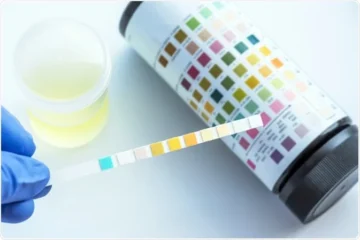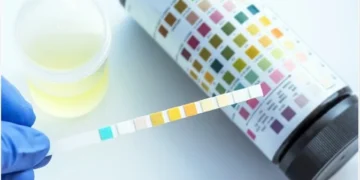A Guide To Children’s Eye Diseases
The visual system develops during pregnancy and continues after birth. On the other hand, children may be unaware that they have a vision problem due to their personal and subjective vision. Because vision issues in babies can cause developmental delays, early detection and treatment are critical for children developing the visual talents they need to learn. To provide the greatest support, advice, and referrals to patients, pharmacists and healthcare professionals should know the stages of visual development and prevalent childhood eye disorders.
To ensure that children’s eyes develop healthily, eye professionals recommend getting their first comprehensive eye checkup at the age of six months. Following this initial visit, your kid should get a second eye check between the ages of 3-5 and again before entering first grade.
Annual exams are necessary as your child grows older to ensure that their eyes develop correctly and detect any vision or ocular health abnormalities.
Stages of vision development:
Infancy (birth to 3 years)
The ability to judge distance (depth perception) develops around five months of age. Two years old should acquire Hand-eye coordination and depth perception.
Preschool (3–5)
The ability to focus on stimuli at various distances and sequences, peripheral vision (moving both eyes in opposite directions to achieve or maintain single binocular vision) and eye movements continue to develop until the child is around five years old. Toys, games, and other activities encourage the development of vision. Before starting school, children aged 3–5 should have a comprehensive optometric eye examination to ensure proper vision development and no eye disease.
School Age (6–18 years)
Children and parents may not be aware of vision changes. Children aged 6–18 should have an eye examination every two years or more if specific problems or risk factors exist or if an ophthalmologist recommends it. The most common vision issue is myopia (nearsightedness), but some kids experience farsightedness or astigmatism. Disabilities in eye focusing, tracking, and coordination can impact academic and athletic performance.
Here are some common eye disorders you should know about:
Hyperopia:
It’s a condition in which a person can see far away objects more clearly than close ones. Farsightedness is common in infants and young children, although it fades as the eye develops. Hyperopia can be more severe in some children, resulting in a blurry image in one or both eyes and preventing normal visual development.
Cataract:
Cataracts(clouding of the lens of eyes) should be detected and treated early in childhood to minimize development. A pediatric ophthalmologist can successfully treat this unusual disease.
Retinopathy of prematurity:
Retinopathy of prematurity (ROP) is an eye illness that affects premature neonates. The retina and its blood vessels are not fully developed in preterm babies. Scarring in the retina occurs typically in both eyes and can cause blindness.
Night Blindness:
Night blindness is the inability of the eyes to adjust to dim light due to a Vitamin A deficiency. People with night blindness have limited vision in the dark, although they can generally see enough light.
Blindness due to vitamin deficiency:
The most common cause of preventable childhood blindness is vitamin A deficiency. Every year, between 2.5 and 5 lakhs of malnourished children in impoverished countries are blind due to Vitamin A deficiency. A well-balanced diet with plenty of Vitamin A can help you overcome this problem.
Ambylopia:
“Lazy Eye” is another name for it. A condition in which one eye’s vision is impaired due to misalignment of the eyes (strabismus). If detected early, treatment can be easy; but, if seen later, it is difficult to treat, and children may experience lifelong vision loss.
Cortical visual impairment:
It is a loss of eyesight caused by an anomaly in the brain’s visual center. The eyes are normal, but the brain’s optical impairment center is malfunctioning, preventing normal vision.
Children ptosis:
In youngsters, the weakening of the muscles that elevate the eyelid causes ptosis or drooping of the eyelids. A droopy eye can prevent light from reaching the retina in the rear of the eye and cause considerable astigmatism, resulting in a hazy image. These circumstances can lead to a lazy eye, which, if left untreated, can lead to vision loss.
Myopia:
Nearsightedness is a condition in which a person can see close items more clearly than far away objects. The Lazy eye is a condition caused by excessive myopia in youngsters (Amblyopia). Squinting and holding things very near may indicate severe myopia.
Chalazion:
It appears to be a tiny bump on the upper eyelid. When a meibomian gland (an oil-secreting gland in the eyelid) becomes clogged, it might cause this. A Chalazion can develop from the size of a poppy seed to the size of a pea. It can affect either the upper or lower eyelids or both. It frequently occurs more than once.
The visual system develops during pregnancy and continues after birth. On the other hand, children may be unaware that they have a vision problem due to their personal and subjective vision. Because vision issues in babies can cause developmental delays, early detection and treatment are critical for children developing the visual talents they need to learn. To provide the greatest support, advice, and referrals to patients, pharmacists and healthcare professionals should know the stages of visual development and prevalent childhood eye disorders.
To ensure that children’s eyes develop healthily, eye specialists recommend getting their first comprehensive eye checkup at the age of six months. Following this initial visit, your kid should get a second eye check between the ages of 3-5 and again before entering first grade.
Annual exams are necessary as your child grows older to ensure that their eyes develop correctly and detect any vision or ocular health abnormalities.
Stages of vision development:
Infancy (birth to 3 years)
The ability to judge distance (depth perception) develops around five months of age. Two years old should acquire Hand-eye coordination and depth perception.
Preschool (3–5)
The ability to focus on stimuli at various distances and sequences, peripheral vision (moving both eyes in opposite directions to achieve or maintain single binocular vision) and eye movements continue to develop until the child is around five years old. Toys, games, and other activities encourage the development of vision. Before starting school, children aged 3–5 should have a comprehensive optometric eye examination to ensure proper vision development and no eye disease.
School Age (6–18 years)
Children and parents may not be aware of vision changes. Children aged 6–18 should have an eye examination every two years or more if specific problems or risk factors exist or if an ophthalmologist recommends it. The most common vision issue is myopia (nearsightedness), but some kids experience farsightedness or astigmatism. Disabilities in eye focusing, tracking, and coordination can impact academic and athletic performance.
Here are some common eye disorders you should know about:
Hyperopia:
It’s a condition in which a person can see far away objects more clearly than close ones. Farsightedness is common in infants and young children, although it fades as the eye develops. Hyperopia can be more severe in some children, resulting in a blurry image in one or both eyes and preventing normal visual development.
Cataract:
Cataracts(clouding of the lens of eyes) should be detected and treated early in childhood to minimize development. A pediatric ophthalmologist can successfully treat this unusual disease.
Retinopathy of prematurity:
Retinopathy of prematurity (ROP) is an eye illness that affects premature neonates. The retina and its blood vessels are not fully developed in preterm babies. Scarring in the retina occurs typically in both eyes and can cause blindness.
Night Blindness:
Night blindness is the inability of the eyes to adjust to dim light due to a Vitamin A deficiency. People with night blindness have limited vision in the dark, although they can generally see enough light.
Blindness due to vitamin deficiency:
The most common cause of preventable childhood blindness is vitamin A deficiency. Every year, between 2.5 and 5 lakhs of malnourished children in impoverished countries are blind due to Vitamin A deficiency. A well-balanced diet with plenty of Vitamin A can help you overcome this problem.
Ambylopia:
“Lazy Eye” is another name for it. A condition in which one eye’s vision is impaired due to misalignment of the eyes (strabismus). If detected early, treatment can be easy; but, if seen later, it is difficult to treat, and children may experience lifelong vision loss.
Cortical visual impairment:
It is a loss of eyesight caused by an anomaly in the brain’s visual center. The eyes are normal, but the brain’s optical impairment center is malfunctioning, preventing normal vision.
Children ptosis:
In youngsters, the weakening of the muscles that elevate the eyelid causes ptosis or drooping of the eyelids. A droopy eye can prevent light from reaching the retina in the rear of the eye and cause considerable astigmatism, resulting in a hazy image. These circumstances can lead to a lazy eye, which, if left untreated, can lead to vision loss.
Myopia:
Nearsightedness is a condition in which a person can see close items more clearly than far away objects. The Lazy eye is a condition caused by excessive myopia in youngsters (Amblyopia). Squinting and holding things very near may indicate severe myopia.
Chalazion:
It appears to be a tiny bump on the upper eyelid. When a meibomian gland (an oil-secreting gland in the eyelid) becomes clogged, it might cause this. A Chalazion can develop from the size of a poppy seed to the size of a pea. It can affect either the upper or lower eyelids or both. It frequently occurs more than once.
FAQs
What are common eye diseases in children?
Common eye problems in children include strabismus, chalazion, amblyopia and refractive error.
How do you know if your child has eye problem?
Here are several symptoms that your youngster may require glasses or contacts:
- Squinting
- Head tilted or one eye covered.
- Too near to the TV or too close to the eyes with handheld devices.
- Excessive eye rubbing
- Headaches or eye pain.
What is normal vision for 5 years old?
Kids 5+ usually see 20/25 or better. The exam involves having your youngster read letters on a wall chart that get smaller and smaller. Kids sometimes give up on the chart when they can read smaller letters.











